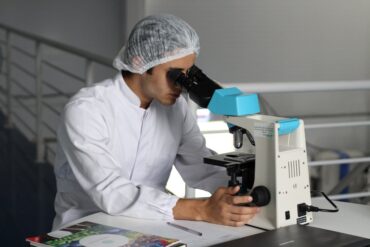
What are AIN lesions?
Precancerous lesions that precede the appearance of cancer in the anal canal have been clearly described.
In the anal canal, at the sphincter level, we find metaplastic epithelium (like in the cervix). Intraepithelial lesions caused by HPV in the area are called AIN (Anal Intraepithelial Neoplasia).
It is believed that AIN lesions behave like the corresponding CIN lesions in the cervix (they both start in metaplastic type squamous epithelium).
How are AIN lesions classified?
The classification of AIN lesions is similar to that of cervical CIN lesions.
If the atypical cells cover the entire thickness of the epithelium, the lesions are classified as AIN3. In those cases where they cover the two lower thirds, they are called AIN2. When they only cover the lower third of the epithelium, they are called AIN1.
What is the prognosis for AIN lesions?
The physical history of carcinogenesis in the anal canal has not been fully clarified, like it has for the cervix. However, several studies have been published in the past ten years, which lead to similar conclusions as regards the potential of the lesions for carcinogenesis.
AIN1 lesions are considered mild infectious lesions. They are also called low-grade and are referred to with the international term LSIL.
AIN2 and AIN3 lesions are classified as “high-grade” or HSIL and are considered precancerous.
What are PaIN lesions and how can they be classified?
PaIN (Peri-Anal Intraepithelial Neoplasia): Intraepithelial Neoplasia of the skin epithelium in the perianal area.
The behavior of PaIN lesions is similar to that of VIN lesions (in the vulva).
Who is at risk for AIN and PaIN?
The following are considered high-risk groups for AIN:
- People who engage in anal sex are at risk for AIN and PaIN
- The risk appears to increase in older ages and smokers
- People with a history of genital warts in the anus
- People with chronic immunosuppression due to HIV infection (AIDS)
- People under chronic pharmaceutical immunosuppression (patients with transplanted organs, chronic users of cortisone, etc.)
- Women with a history of precancerous lesions in the lower reproductive system
What preventive measures are recommended?
- Vaccination
- Screening of population groups that are considered high-risk in order to detect any lesions
- Safe sex with use of a condom, careful selection of sexual partners, restriction of the number of sexual partners.
- Quitting smoking
- A healthy lifestyle
Are there symptoms from the AIN/PaIN lesions?
There are usually no symptoms. In isolated cases, patients report itching or unusual anal discharge.
How are the lesions diagnosed?
It is considered useful for high-risk groups to have check-ups after a certain age. There are no clear instructions yet, but considering that anal cancer usually appears after the age of 50, it would
be reasonable to start getting check-ups before that.
The Pap test (collecting cells from the anal canal) is already used as a preventive check-up method. Its reliability is not very high (as it is in the cervix) and it is believed that in the future it will be combined with molecular techniques.
The examination of the mucosa of the anal canal and the skin of the perianal area with the colposcope, called High-Resolution Anoscopy, is considered very reliable for finding precancerous AIN and PaIN lesions. If lesions are discovered, biopsies are taken.
A digital rectal examination must always be performed to exclude a palpable tumor.
How are AIN/PaIN lesions treated?
PaIN lesions are treated the same way as VIN lesions.
AIN lesions require the doctor’s specialization in the field, because their treatment is not always easy and there are frequent complications.
Which AIN lesions require treatment?
It is recommended that only HSIL lesions are treated, and in particular AIN3 lesions. Some cases with AIN2 lesions can be followed up with biopsies over a certain period.
How are high-grade lesions (HSIL/AIN2, 3) treated?
Many methods have been tried.
Among non-surgical methods, it appears that the imiquimod cream has relatively good results.
Among surgical techniques, laser ablation of the epithelium or cauterisation are preferred when there is no suspicion of underlying invasive cancer.
In serious lesions, where the possibility of invasive cancer cannot be excluded, the lesions are removed with a scalpel, and an effort is made to anatomically restore the area. This is easier in the case of lesions that do not spread out more than 1/3 of the perimeter of the anal canal.
Do AIN and PaIN lesions recur after treatment? Is followup necessary?
Both PaIN and AIN lesions frequently recur after treatment and require regular follow-up.
Quitting smoking is also recommended. Smoking is an exacerbating factor for carcinogenesis from HPV in the anus, as well as in the lower genital tract in general.
How frequent are HSIL/AIN2, 3 lesions in the general population?
The incidence of HSIL/AIN2, 3 lesions is currently considered to be less than 1% in the general population. There are, however, indications that this percentage will increase in the future due to the epidemic of infections by HPV.
Are women with high-grade lesions (HSIL) in an organ at an increased risk for similar lesions in other organs?
The risk is clearly higher than the rest of the population and the recommendation is to monitor the entire lower genital tract and the anal area.
For example, women with a CIN3 history have increased risk for carcinogenesis from HPV in other areas.
More specifically:
- Seven times higher risk for vaginal cancer
- Two times higher risk for vulvar cancer
- Five times higher risk for anal cancer





